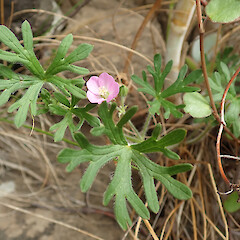Geranium solanderi
Common name
Solander’s geranium
Synonyms
Geranium dissectum var. pilosum Hook.f.; Geranium dissectum var. australe Benth.; Geranium carolinianum var. australe (Benth.) Fosberg; Geranium dissectum f. tasmanica Gand.; Geranium drummondii Carolin
Family
Geraniaceae
Flora category
Vascular – Native
Endemic taxon
No
Endemic genus
No
Endemic family
No
Structural class
Herbs - Dicotyledons other than Composites
NVS code
The National Vegetation Survey (NVS) Databank is a physical archive and electronic databank containing records of over 94,000 vegetation survey plots - including data from over 19,000 permanent plots. NVS maintains a standard set of species code abbreviations that correspond to standard scientific plant names from the Ngä Tipu o Aotearoa - New Zealand Plants database.
GERSOL
Chromosome number
2n = 52
Current conservation status
The conservation status of all known New Zealand vascular plant taxa at the rank of species and below were reassessed in 2017 using the New Zealand Threat Classification System (NZTCS) – more information about this can be found on the NZTCS website. This report includes a statistical summary and brief notes on changes since 2012 and replaces all previous NZTCS lists for vascular plants.
Please note, threat classifications are often suggested by authors when publications fall between NZTCS assessment periods – an interim threat classification status has not been assessed by the NZTCS panel.
- Conservation status of New Zealand indigenous vascular plants, 2017 . 2018. Peter J. de Lange, Jeremy R. Rolfe, John W. Barkla, Shannel P. Courtney, Paul D. Champion, Leon R. Perrie, Sarah M. Beadel, Kerry A. Ford, Ilse Breitwieser, Ines Schönberger, Rowan Hindmarsh-Walls, Peter B. Heenan and Kate Ladley. Department of Conservation. Source: NZTCS and licensed by DOC for reuse under the Creative Commons Attribution 4.0 International licence.
2017 | At Risk – Declining | Qualifiers: DP, SO
Previous conservation statuses
2012 | At Risk – Declining | Qualifiers: DP, SO
2009 | Not Threatened
2004 | Not Threatened
Distribution
Indigneous. North, South and Chatham Islands (including many northern offshore islands). Indigenous to Australia.
Habitat
Coastal to montane (0-600 m a.s.l.). Formerly widespread in short tussock grasslands, on lava fields, clay pans and on rocky coastal headlands.
Detailed description
Perennial herb 0.12–1.0 m tall. Rootstock 2.4–19.1 mm diam., without fusiform roots. Stem erect to ascending, with straight, patent to retrorse, non-appressed, eglandular hairs 0.4–1.8 mm long. Basal leaves in a ± deciduous rosette; lamina 12–45 × 14–57 mm, polygonal in outline, cordate, palmatifid (divided for 0.5–0.8 of its length), pilose, with ± erect, eglandular hairs; segments 5–7, obtriangular, 2.2–6.8 mm at the base; petioles to 180 mm long, with patent, eglandular hairs 0.4–1.7 mm long; stipules 2.2–8 × 0.5–2.1 mm, with eglandular hairs on abaxial surface and on the margin, glabrous adaxially. Inflorescence 2-flowered cymules, solitary; peduncles (4)–40–(61) cm long, with patent to retrorse, not appressed, eglandular hairs 0.3–2.0 mm long; bracteoles 1.5–7.4 × 0.3–0.8 mm, lanceolate, with eglandular hairs on abaxial surface and on the margin, glabrous adaxially; pedicels 8–34 mm long, with patent to retrorse, not appressed, eglandular hairs 0.2–2.0 mm long; pedicel and peduncle together usually overtopping the subtending leaf. Sepals (3.2)–4.2–5.2–(6.3) × 1.6–2.7 mm, lanceolate, with scarious margins 0.1–0.2 mm wide, with eglandular hairs 0.1 mm long on the abaxial side (and eglandular hairs 0.4–1.8 mm long on the margin), glabrous adaxially. Petals (3)–6–(8.1) × 1.4–4.2 mm, entire, without claw, glabrous on both sides, ciliate on the basal margin, purplish. Filaments 2.4–4.5 mm long, yellowish, glabrous on both sides, ciliate on the basal margin, with hairs up to 0.1–0.3 mm long; anthers 0.4–0.8 × 0.2–0.7 mm, yellowish. Nectaries glabrous. Gynoecium 2.5–4.8 mm long, yellowish. Fruit 13.1–20.6 mm long; mericarps 2.2–3.2 ×1.1–1.8 mm, smooth, with erect-patent, eglandular hairs 0.1–1.5 mm long, usually blackish; rostrum 8.8–15.1 mm long, without a narrowed apex, with erect-patent, eglandular hairs 0.1–1.1 mm long; stigmatic remains (0.6)–1–1.4–(1.6) mm long, with 5 hairy lobes. Seeds 1.6–2.2 × 0.9–1.6 mm, reticulate.
Similar taxa
Most frequently confused with G. retrorsum DC. from which it differs by the long hairs of the petiole and pedicel being straight, patent or curved and retrorse but never appressed rather than distinctively retrorse and appressed, and by the dorsal alveolae of the seed being mostly 5–6- rather than 4–6-sided, and up to >0.1 mm rather than c. 0.1 mm diameter. The rootstock of G. retrorsum is often turnip-shaped, whereas in G. solanderi the root is more like a long tapering parsnip or carrot.
Flowering
September–April
Flower colours
Violet/Purple
Fruiting
October–June
Life cycle
Seed dispersed by wind, ballistic projection and possibly attachment (Thorsen et al., 2009).
Propagation technique
Easily grown from fresh seed. Thrives in a sunny, well drained soil in full sun. It can become invasive but is easily controlled. A very attractive plant well worth cultivating.
Threats
It has declined from large parts of its former range due to rabbit browsing and the spread of taller, faster growing weeds. If these factors continue it may well qualify in the not too distant future as Threatened.
Etymology
geranium: From the Greek geranos ‘crane’, the fruit of the plant resembling the head and beak of this bird, hence the common name cranesbill.
solanderi: Named after Daniel Carlsson Solander (19 February 1733 - 13 May 1782) who was a Swedish naturalist and an apostle of Carl Linnaeus.
Attribution
Fact Sheet prepared by P.J. de Lange (14 April 2008). Description adapted from Aedo et al. (2005), supplemented with observations based on fresh and cultivated specimens.
References and further reading
Aedo C, Fiz O, Alarcón ML, Navarro C, Aldasoro JJ. 2005. Taxonomic revision of Geranium sect. Dissecta (Geraniaceae). Systematic Botany 30: 533–558.
Thorsen MJ, Dickinson KJM, Seddon PJ. 2009. Seed dispersal systems in the New Zealand flora. Perspectives in Plant Ecology, Evolution and Systematics 11: 285–309.
NZPCN Fact Sheet citation
Please cite as: de Lange, P.J. (Year at time of access): Geranium solanderi Fact Sheet (content continuously updated). New Zealand Plant Conservation Network. https://www.nzpcn.org.nz/flora/species/geranium-solanderi/ (Date website was queried)



















